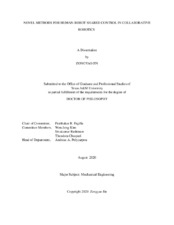| dc.description.abstract | Blended shared control is a method to continuously combine control inputs from traditional automatic control systems and human operators for control of machines. An automatic control system generates control input based on feedback of measured signals, whereas a human operator generates control input based on experience, task knowledge, and awareness and sensing of the environment in which the machine is operating. Such active blending of inputs from the automatic control agent and the human agent to jointly control machines is expected to provide benefits in terms of utilizing the unique features of both agents, i.e., better task execution performance of automatic control systems based on sensed signals and maintaining situation awareness by having the human in the loop to handle safety concerns and environmental uncertainties. The shared control approach in this sense provides an alternative to full autonomy. Many existing and future applications of such an approach include automobiles, underwater vehicles, ships, airplanes, construction machines, space manipulators, surgery robots, and power wheelchairs, where machines are still mostly operated by human operators for safety concerns. Developing machines for full autonomy requires not only advances in machines but also the ability to sense the environment by placing sensors in it; the latter could be a very difficult task for many such applications due to perceived uncertainties and changing conditions. The notion of blended shared control, as a more practical alternative to full autonomy, enables keeping the human operator in the loop to initiate machine actions with real-time intelligent assistance provided by automatic control.
The problem of how to blend the two inputs and development of associated scientific tools to formalize and achieve blended shared control is the focus of this work. Specifically, the following essential aspects are investigated and studied. Task learning: modeling of a human-operated robotic task from demonstration into subgoals such that execution patterns are captured in a simple manner and provide reference for human intent prediction and automatic control generation. Intent prediction: prediction of human operator's intent in the framework of subgoal models such that it encodes the probability of a human operator seeking a particular subgoal. Input blending: generating automatic control input and dynamically combining it with human operator's input based on prediction probability; this will also account for situations where the human operator may take unexpected actions to avoid danger by yielding full control authority to the human operator. Subgoal adjustment: adjusting the learned, nominal task model dynamically to adapt to task changes, such as changes to target object, which will cause the nominal model learned from demonstration to lose its effectiveness.
This dissertation formalizes these notions and develops novel tools and algorithms for enabling blended shared control. To evaluate the developed scientific tools and algorithms, a scaled hydraulic excavator for a typical trenching and truck-loading task is employed as a specific example. Experimental results are provided to corroborate the tools and methods.
To expand the developed methods and further explore shared control with different applications, this dissertation also studied the collaborative operation of robot manipulators. Specifically, various operational interfaces are systematically designed, a hybrid force-motion controller is integrated with shared control in a mixed world-robot frame to facilitate human-robot collaboration, and a method that utilizes vision-based feedback to predict the human operator's intent and provides shared control assistance is proposed. These methods provide ways for human operators to remotely control robotic manipulators effectively while receiving assistance by intelligent shared control in different applications. Several robotic manipulation experiments were conducted to corroborate the expanded shared control methods by utilizing different industrial robots. | en |


